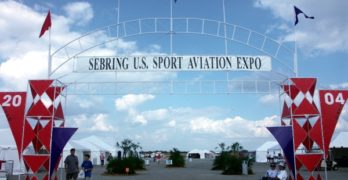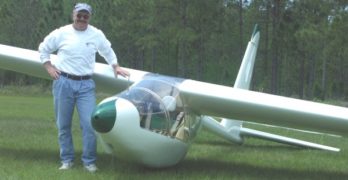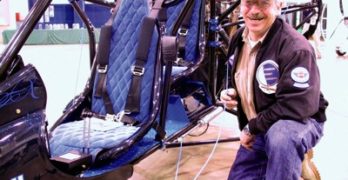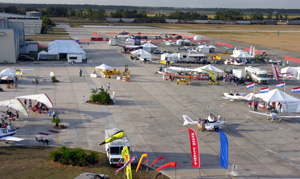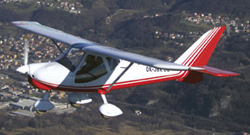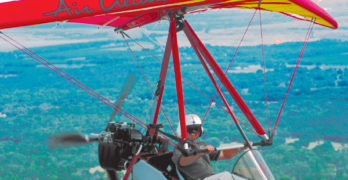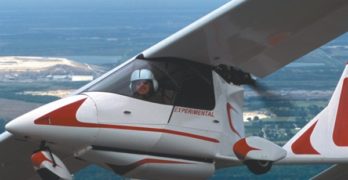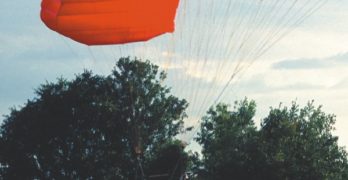The U.S. Sport Aviation Expo in October 2004 was the first event to focus exclusively on Light-Sport Aircraft.
ou never get a second chance to make a first impression. With that in mind, you might ask how visitors regarded the first U.S. Sport Aviation Expo, held in Sebring, Florida, from October 28-31, 2004. The Expo was the first of its kind aiming at the new Sport Pilot/Light-Sport Aircraft (LSA) segment, and it was a focused event, featuring only LSAs and ultralights. Is that two strikes against it or two good reasons for it to succeed?
From what I could see, those who attended the Sebring event were satisfied. Set aside for the moment reports elsewhere that the show was sparsely attended. It was the first of its kind. And as word of mouth is accepted to be the best marketing tool for shows, the attendance figures should present no surprise. The vendors were satisfied, and visitors also seemed to feel good about the selection of aircraft, the availability and ease of demo flights and the wide array of educational forums.
Search Results for : Flight Design
Not finding exactly what you expected? Try our advanced search option.
Select a manufacturer to go straight to all our content about that manufacturer.
Select an aircraft model to go straight to all our content about that model.
Ultralight Flyer Goes the Distance
There’s only one Carbon Dragon currently flying; it belongs to Steve Arndt, who calls his beautiful version of this ultralight sailplane the Magic Dragon. What he can do with it is indeed quite magical.
On a day when experienced hang glider pilots were only getting in short, half-hour soaring flights at Florida’s well-known Wallaby Ranch Flight Park, Arndt appeared to be gearing up for an entire afternoon of soaring.
“Oh, he’ll be up 3 hours, and we won’t see him until he decides to come back for dinner,” said Wallaby Ranch proprietor Malcolm Jones. Such is the nature of flying the unusually lightweight Carbon Dragon. Most soaring pilots would agree that Arndt’s sailplane and his flying are both remarkable.
An Ultralight Glider
Designed by a team led by the late Jim Maupin and Irv Culver, the Carbon Dragon has a 44-foot wingspan with full-span flaperons, an empty weight of 145 pounds and a gross weight of 335 pounds.
Hand Control PPC
One innovative designer offers an alternative to foot-controlled powered parachute flight.
For those of you that don’t know, most powered parachutes are steered around the sky using your legs. Pushing with your right leg exerts downward force on a steering line routed to the right trailing edge of the canopy/wing, producing drag on that side and initiating a turn in that direction.
The motion isn’t hard-though some designers have added mechanical advantage to make it easier-and the turn is more responsive that you might imagine. But what if you don’t have good use of your legs? How might you fly a powered parachute?
Canadian powered parachute manufacturer Para-Ski offers a handlebar arrangement, and other companies have experimented with similar ideas. But nearly every other supplier of these flying machines uses a foot-steering arrangement of one kind or another. James Leon of Kankakee, Illinois, has another alternative.
Call It Power Steering
While Para-Ski has its handlebars, a measure of physical effort is still involved.
Fk-9 Mark III
Sleek composite microlight performs like a GA aircraft In the Dec. 11 Flyer, I wrote about the Albatros, which I call a hybrid ultralight because it bridges older tube-and-rag ultralights and new all-composite models.
This month we look at the German-built FK-9 from B&F Technik. A new breed with an interesting history, it too emerged from an earlier design. In fact, the FK-9 shown in photos that accompany this story is the glass-fiber Mark 3. Its predecessors, the Mark 1 and Mark 2, used fabric skins, putting them more in the hybrid category.
To review briefly, hybrid microlights are flying machines that employ the best ideas of familiar ultralight designs, such as sewn Dacron wings and aluminum airframes, yet combine those proven components with composite fuselages and welded steel parts. Simple construction keeps many small builders in business.
Conversely, the composite microlights are typically all-composite designs (or composite over steel) using newer construction technology and techniques.
Tom Ivicevich’s Wright Flyer
The Wrightness of one man’s dream
On December 17, 2003, Tom Ivicevich’s Wright Flyer won’t represent the only attempt to recreate the brothers’ famous accomplishment. Nor will he be the only Wright pilot flying cross-country to arrive at the sand dune shrine in Kitty Hawk, North Carolina. But Ivicevich will do it all without major sponsorships. And he intends to fly coast to coast in his enhanced version of the original Wright Flyer.
This is one man’s dream, and he is well underway to reaching his goal.
Creating Interest
In January this year, Ivicevich’s 5¼8-scale Flyer flew while being towed by a 1930 Model A pickup truck at Redding Municipal Airport in California. The 190-pound aircraft took readily to the air at 25 mph.
In February, Ivicevich announced, “I am now organizing the start of construction for the full-size Flyer.” Next year, he plans to launch from Torrance, California, and make his way across the country.
Sebring II Is Proving a Big Success
The second running of Sebring is a success by any measure. Days one and two enjoyed warm weather with good conditions for a large number of demo fllights. One fascinating development was the arrival of some top Cessna officials who evidently came to check out the LSA scene although their presence was relatively low key (however, it’s hard to hide a bizjet on the ramp among a flock of LSA). No one was saying what might transpire. Sport Aircraft of all varieties were present including most fixed wings and several trikes and powered parachutes. Sebring visitors also saw the arrival of the first flying version of the Advanced Aero Inverted V design. According to lead engineer Chris Gagliano, “Our single seat prototype has already completed six hours of flight time after its first flight on December 30, 2005.” Chris, his father, and their team are at work on the two seater and their work has progressed logically through computer models and physical models.
SportRider Wins SLSA Approval
After a short lull in new approvals, the first to announce winning FAA’s blessing following AirVenture Oshkosh 2005 is AveoUSA’s SportRider. Designed by Jaro Dostal, the same man who created the comfortable SkyBoy, SportRider is built by Gryf Air of the Czech Republic and handled by FlyItalia. Sport Rider is sold in America by Texas-based AveoUSA. Once folks returned home from EAA’s big show this year, I got several emails from pilots asking about this handsome aircraft with its flowing lines and 46-inch-wide cockpit. You can see my early report in the August 2005 Kitplanes magazine and I hope to do a pilot report this fall, perhaps on one of the EAA Sport Pilot Tours where you can also go for a demo flight.
Air Creation Buggy/Kiss
For many years, I’ve been critical of trike handling. While I try never to forecast the future, I’ve gone out on a limb and predicted that rigid-wings will eventually become commonplace on trikes (though I don’t also predict delta wings will disappear).
Going Rigid?
Rigid-wings look a lot like modern hang gliders and trike wings in many ways, but they have control surfaces. Because these surfaces are deployed via weight-shift movements they neatly combine the benefits of 3-axis ultralights – lower control forces and good control authority – with the elegant simplicity of weight-shift. Rigid-wings can carry good weight and are somewhat faster than delta wings (called “flex wings” by hang glider pilots), and they also handle more easily. I think this makes them a nearly inevitable development.
While I still believe rigid-wings are coming to trikes, it may take longer than I thought because the trike industry may finally be rising to the challenge.
All the Plane You May Want
Over the years, Titan Aircraft has made their Tornado a familiar aircraft seen at flight parks and airports around the nation. Since it was introduced in ’91, the sleek, efficient plane has evolved into a variety of models.
This month we examine the fine work of Roger Bacon who created a lovely red-and-white Tornado II 912, powered by the 100-hp Rotax 912S 4-stroke powerplant expected to be commonplace on light-sport aircraft. Bacon’s airplane is licensed in the Amateur-built category but its facts and figures suggest it could be flown with FAA’s proposed Sport Pilot certificate (until FAA’s new rule is introduced, a private pilot’s certificate or better is required).
Usually I prefer to fly a factory airplane to make sure it correctly represents what a buyer might receive. However, Bacon’s model is so well done, Titan Aircraft encouraged a test flight. Thanks to Bacon for his willingness to let me take his pride and joy aloft.
Hybrid Powered Chute
As focus sharpens on FAA’s proposed Light-Sport Aircraft regulation, the first aircraft segment to complete an ASTM airworthiness consensus standard is powered parachutes. While these aircraft are simpler, which helped speed the process, participating manufacturers got together well and hammered out their certification rules efficiently.
Summit Powered Parachutes of Canada hasn’t yet chosen to enter the Light-Sport Aircraft arena. They aren’t worried, just wary of new regulations. In fact, the company started work under England’s BCAR S regulation. Just recently, Summit was working to qualify for German DHV certification. They see no great challenge passing the proposed U.S. powered parachute standards, as currently defined.
Fortunately, the proposed Light-Sport Aircraft is not the only destination in sport aviation. It may be part of the spectrum of aviation regulations.
We’re seeing more new designs tuned to Part 103. And the Amateur-Built 51% rule will still allow many 2-seat ultralights to be built and flown as they are today.
- « Previous Page
- 1
- …
- 122
- 123
- 124
- 125
- 126
- …
- 148
- Next Page »


